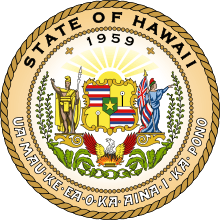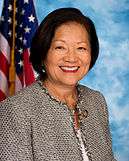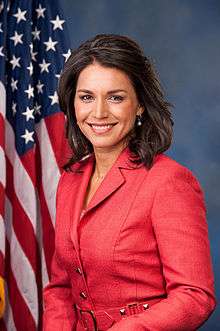Politics of Hawaii
 |
| This article is part of a series on the politics and government of Hawaii |
|
Constitution |
|
|
Inferior Jurisdictions |
|
History and current issues
This only covers the history of the politics of the State of Hawaii. For information on the political history of the previous two forms of government, see Territory of Hawaii - Organic Act and Kingdom of Hawaii - Government.
State government
Congressional representation
Hawaii's congressional politics are typically dominated by Democrats. The state has elected just one Republican U.S. senator, Hiram Fong, who served from 1959 to 1977, and two GOP House members. The rest have been Democrats. Hawaii is currently represented in the Senate by Democrats Mazie Hirono and Brian Schatz. In the House, Mark Takai (HI-1) and Tulsi Gabbard (HI-2) represent the state.
County governments
City and County of Honolulu- Kirk Caldwell
County of Hawaii- William "Billy" Kenoi
County of Maui- Alan Arakawa
County of Kauai- Bernard Carvalho
Political parties
Dominant party system
Hawaii has run on a Dominant party system, even misinterpreted as a Single-Party system. The legislative majority tends to hold significantly more power than any minority power and the position of the government and the position of the ruling party are closely aligned. This system was largely brought about by the 1887 Constitution which was forced on King David Kalākaua by what is now known as the Hawaii Republic Bayonet Constitution. The constitution diminished the power of the monarchy and empowered the legislature.
Hawaiian nationalism


Hawaiian nationalism is focused on producing a national identity. Most Hawaiian nationalists have argued that the Hawaiian race and their descendants should govern the islands as a constitutional monarchy. It is also important to note that Hawaiian nationalism is not limited to Native Hawaiians but have included other groups including Whites and Asians such as Walter M. Gibson.
However, most citizens of Hawaii support continued membership in the United States and disregard separatist views.
Presidential elections
| Year | Republican | Democratic |
|---|---|---|
| 2012 | 27.84% 121,015 | 70.55% 306,658 |
| 2008 | 26.58% 120,446 | 71.85% 325,588 |
| 2004 | 45.26% 194,191 | 54.01% 231,708 |
| 2000 | 37.46% 137,845 | 55.79% 205,286 |
| 1996 | 31.64% 113,943 | 56.93% 205,012 |
| 1992 | 36.70% 136,822 | 48.09% 179,310 |
| 1988 | 44.75%' 158,625 | 54.27% 192,364 |
| 1984 | 55.10% 185,050 | 43.82% 147,154 |
| 1980 | 42.90% 130,112 | 44.80% 135,879 |
| 1976 | 48.06% 140,003 | 50.59% 147,375 |
| 1972 | 62.48% 168,865 | 37.52% 101,409 |
| 1968 | 38.70% 91,425 | 59.83% 141,324 |
| 1964 | 21.24%' 44,022 | 78.76% 163,249 |
| 1960 | 49.97% 92,295 | 50.03% 92,410 |
Hawaii is dominated by the Democratic Party and has supported Democrats in every presidential in which it has participated, except 1972 and 1984, when the incumbent Republican candidates won 49-state landslides. In 2004, John Kerry won the state's 4 electoral votes by a margin of 9 percentage points with 54% of the vote. Every county in the state supported the Democratic candidate. In 2008, Hawaii native Barack Obama won by an overwhelming 45 point lead: 72% for the Democrat and 27% for Republican John McCain. Hawaii is the only actual state that gave either candidate more than 70% of the vote. Obama again won Hawaii by a large margin in 2012, suffering only a small swing against him, winning 71% to 28% for Republican Mitt Romney. Hawaii once again gave a higher vote share to Obama than any of the 49 other states, though on this occasion, Obama's vote was not quite as high as his challenger's best state (Utah, where Mormon Romney polled 73%).



